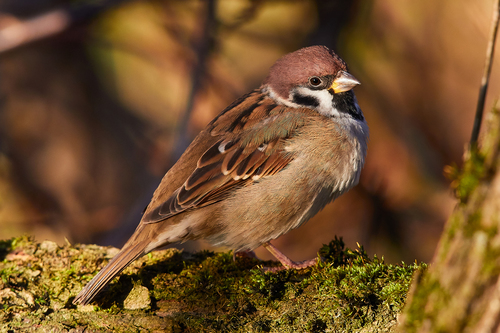
Eurasian Tree Sparrow
The Eurasian Tree Sparrow (*Passer montanus*) is a small, charming bird with a rich chestnut crown and nape, and a black patch on its white cheeks. It plays a significant ecological role as both a seed disperser and an insect predator, particularly during breeding season. Unlike its close relative, the House Sparrow, the Eurasian Tree Sparrow prefers more open habitats and is less tied to human habitation, although it can be found in rural and suburban areas. While widespread and common in Eurasia, it has experienced declines in some parts of its range, particularly in Western Europe, due to agricultural intensification and habitat loss.
12.5-14 cm
Length
20-22 cm
Wingspan
Least Concern
Conservation Status
Distribution
The Eurasian Tree Sparrow is native to Europe and Asia, with a range extending from Ireland and Spain in the west to Siberia, Japan, and Southeast Asia in the east. Introduced populations exist in the United States (around St. Louis, Missouri), Australia, and the Philippines. They are generally non-migratory in the milder parts of their range but northern populations may migrate south for the winter.
Lifespan
The typical lifespan in the wild is around 3 years, although individuals can live longer. In captivity, they may live for up to a decade.
Eurasian Tree Sparrow's Habitat
Habitat Types
Open woodlands, Forest edges, Farmlands, Parks, Gardens, Hedgerows
Climate Zones
Temperate, Subtropical, Boreal
Adaptations
Eurasian Tree Sparrows are adaptable to a range of habitats, showing a preference for areas with scattered trees and shrubs providing cover and nesting sites. They are less reliant on human structures than House Sparrows, often nesting in natural tree cavities or utilizing nest boxes.
Variations
Several subspecies of *Passer montanus* are recognized, differing slightly in plumage tone and size. These variations are generally subtle and reflect adaptations to local environmental conditions.
Appearance
Breeding Plumage
Plumage is similar year-round, with no distinct breeding and non-breeding plumages.
Seasonal Feather Changes
Minor seasonal variation may occur, with plumage appearing slightly brighter after molting.
Sex Based Plumage Differences
Males and females have identical plumage, unlike the House Sparrow.
Notable Features
Chestnut-brown crown and nape, Black patch on white cheeks, Black bib (smaller than in House Sparrows), White wing bars
Diet and Feeding
Primary Foods
Seeds, Grains, Insects, Spiders, Berries
Foraging Behavior
Eurasian Tree Sparrows forage on the ground, often in small flocks, hopping and pecking for seeds and insects. They also glean insects from foliage and occasionally take berries from shrubs.
Specializations
They have a relatively strong, conical bill adapted for cracking seeds. During the breeding season, their diet shifts to include a higher proportion of insects, which are essential for feeding nestlings.
Seasonal Diet Variations
The diet is primarily seed-based in winter, shifting to a higher proportion of insects during the spring and summer breeding season when protein demands are higher for both adults and young.
Behavior
Social Structure
Eurasian Tree Sparrows are generally gregarious, forming flocks outside the breeding season. During the breeding season, they may form loose colonies or defend small territories around their nest sites.
Communication
Variety of chirps and calls, Contact calls to maintain flock cohesion, Alarm calls to warn of predators
Migration
Most populations are resident or undertake short-distance movements. Northern populations may migrate south for the winter, but the extent of migration varies depending on the severity of the winter.
Territorial or Group Behaviors
During the breeding season, pairs or small groups may defend territories around nest sites. Outside the breeding season, they form larger, more mobile flocks.
Conservation
Threats
Habitat loss due to agricultural intensification, Loss of nesting sites (e.g., old trees with cavities), Pesticide use affecting insect prey, Competition with House Sparrows in some areas
Protection Programs
Agri-environment schemes promoting biodiversity in farmland, Provision of nest boxes, Habitat restoration projects
Local National Laws
Protected under various national and international wildlife legislation, such as the EU Birds Directive.
Population Trend
Decreasing in parts of Western Europe, but stable or increasing elsewhere. Overall, the global population trend is considered stable.
Population Estimates
The global population is estimated to be between 52,000,000 and 240,000,000 mature individuals.
Interesting Facts
Eurasian Tree Sparrows are less closely associated with humans than House Sparrows.
This is reflected in their preference for more open, rural habitats.
Both male and female Eurasian Tree Sparrows look alike.
This is a key difference from House Sparrows, where males and females have distinct plumage.
They can have multiple broods in a single breeding season.
This allows them to maximize reproductive success in favorable conditions.
They have been introduced to various locations outside of their native range.
Including areas in North America and Australia.
Faqs about Eurasian Tree Sparrow
How can I tell a Eurasian Tree Sparrow from a House Sparrow?
Eurasian Tree Sparrows have a chestnut crown and a black cheek patch, while male House Sparrows have a grey crown and lack the cheek patch. Female House Sparrows are duller overall.
What do Eurasian Tree Sparrows eat?
They eat a mix of seeds, grains, and insects. Their diet varies seasonally, with more insects consumed during the breeding season.
Where do Eurasian Tree Sparrows nest?
They nest in tree cavities, nest boxes, and sometimes in crevices in buildings.
Are Eurasian Tree Sparrows migratory?
Most populations are resident or make short-distance movements. Northern populations may migrate south for the winter.
Copyright @ Nature Style Limited. All Rights Reserved.
 English
English